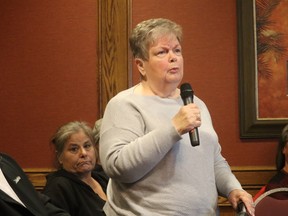
There is an increased risk of leukemia from benzene levels in the air in some areas of Sarnia and Aamjiwnaang First Nation, according to the provincial Sarnia Area Environmental Health Project.
Advertisement 2
Article content
The project also found elevated health risks from sulfur dioxide, especially for asthma sufferers, and particularly during industrial flaring events.
Article content
“We understand that these are upsetting results,” said Rachel Melzer of Ontario’s Environment Ministry. “Our hope is that they can set the stage for very powerful action and that the air will be much better and much safer.”
The health project, launched by the ministry in 2020, reported findings this week in Aamjiwnaang and Point Edward.
The project followed several years of work by the Lambton Community Health Study Board to determine if there were links between local refinery and chemical plant operations and the health of nearby residents.
An air exposure review for 2015-19, part of the provincial project, found the highest risks from benzene are in the northern parts of Aamjiwnaang and industrial areas of south Sarnia.
Advertisement 3
Article content
“These risks require further action to reduce ambient concentrations and protect human health,” the review said.
“The basis for the evaluation of risk for benzene is on a one-in-a-million risk level here in Ontario. That’s the regulated value, one additional instance of cancer in a population of one million people,” said Glenn Ferguson with Intrinsik, one of the consultants that carried out the air exposure review. “So, we are above that level and in some cases, specifically those areas we identified, significantly above.”
“Sadly, many of the findings that you have presented are ones that we were concerned about,” Sarnia Coun. Anne Marie Gillis told ministry officials at a Nov. 29 presentation in Point Edward.
Advertisement 4
Article content
Gillis, who chaired the previous community health study board, asked what would happen with the report’s findings and recommendations.
“Our goal was to generate information that can drive. . . (and) focus action at the ministry,” Melzer said. “Which chemicals? . . . where are the health risks?”
“You, I hope, will hold the ministry’s feet to the fire to make sure it happens,” Melzer said.
The report recommendations on benzene include improving regulatory enforcement to reduce emissions from local industries. It also calls on the ministry to do a scientific review and develop short-term health-based guidelines to help guide monitoring and abatement.
Recommendations on sulfur dioxide call on industry to develop flare minimization plans and provide timely warnings about flaring for nearby residents.
Advertisement 5
Article content
“We’ve been calling for action to reduce pollution in our community for more than 100 years,” Aamjiwnaang First Nation Chief Chris Plain said in a statement. “We need governments to take the necessary steps to ensure the standards are protective of our health and to enforce the rules in place and reduce pollution in our community.”
The ministry delivered results of the project to the First Nation earlier in the week.
What happens now with the project’s findings and recommendations is “the million-dollar question,” said Julie Schroder, director of the ministry’s technical assessment and standards development branch.

The ministry is considering those results and “evaluating the tools that it has already applied for addressing emissions of benzene,” Schroder said.
Advertisement 6
Article content
“We share the concerns about around benzene,” said Jason Vaillant, general manager of the Bluewater Association for Safety, Environment and Sustainability, a Sarnia-based industry group that has supported the project since it began in 2017.
“We’re doing our part in terms of complying with the benzene technical standard” on a “facility-by-facility basis,” he said. “That’s the focus through ongoing efforts to identify leaks through a leak detect and repair program. . . at all the facilities,” and looking at “technologies and strategies to reduce their emissions.”
Any changes in provincial rules around benzene emissions “is in the hands of the ministry,” Vaillant said. “We’ll comply with the regulations that are set out for us, as an industry.”
Advertisement 7
Article content
“We’re committed to continuing the conversation and being part of the process,” he said.
Melzer said while the project was “the most extensive and detailed study” to date of air quality in Ontario, it was “an environment-first study.”
“It didn’t study medical data,” she said. “It studied the environment. It studied the air quality.”
That the project didn’t look at health data was disappointing, Gillis said.
“Hopefully, from this, change is going to come and it will benefit all the communities,” said Sandy Kinart, with the group Victims of Chemical Valley, a project participant.
“We’re not trying to shut industry down,” she said. “We want everything to be better for the community and for the workers.”
The project’s reports are available at cleanairsarniaandarea.com.
Article content
